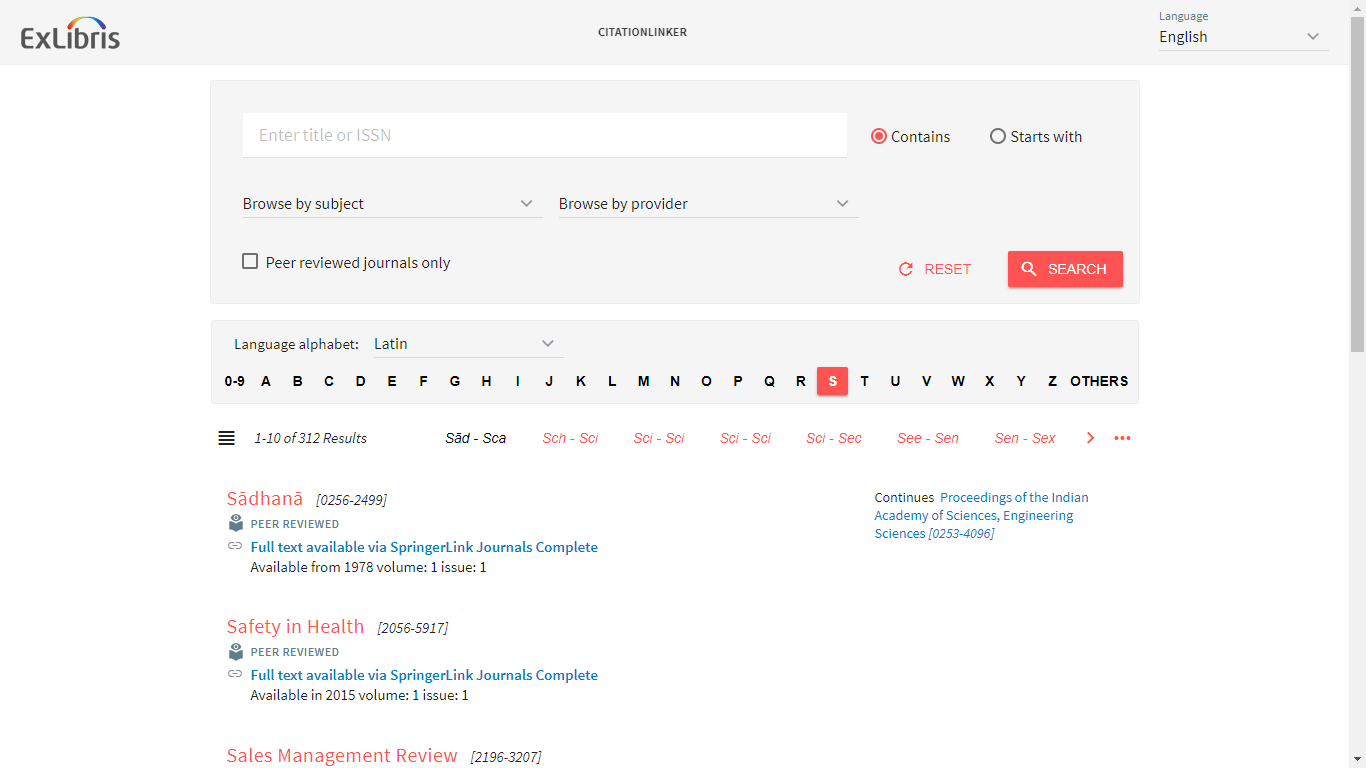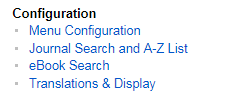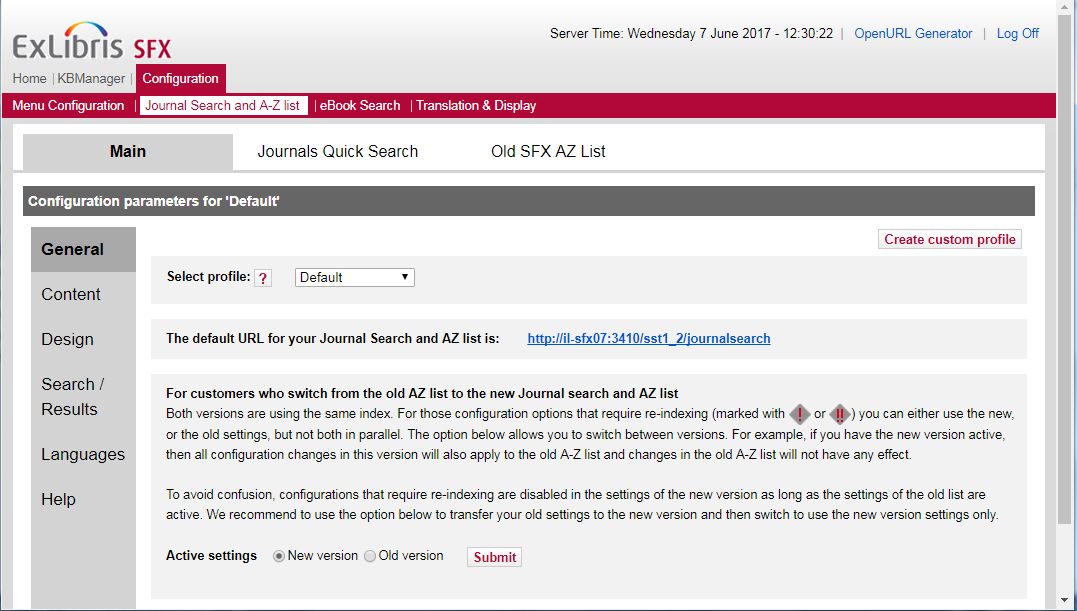How to localize the new SFX Journal search and AZ List
- Product: SFX
- Product Version: June 2017
- Relevant for Installation Type: Multi-Tenant Direct, Dedicated-Direct, Local, TotalCare
Description
With the June 2017 software release we added a new user interface to the SFX Journal Search and AZ List, fully configurable via SFXAdmin. The new User Interface is accessible to every customer under its own URL. It therefore does not affect the old AZ List and customers can switch to the new Journal Search User Interface in their own time.
The new User Interface has a fresh and modern look and provides the user with a state-of-the-art user experience.

All functions are displayed on one page. The new user interface does not use tabs anymore to navigate the user between the search and browse functions and the filters (category, information provider, peer reviewed). Each of these elements can be removed from the user interface by the institution if desired, for example if you do not wish to use the vendor or the category filter, you can remove them from view.
The user interface also incorporates some changes to reduce the number of clicks to get to the full text as well as to view the details of a listed journal. For example the details of a journal as well as services that are usually shown on the link menu can now be accessed in a sidebar by clicking on the journal title. A click on the target platform in the result list takes the user directly to the journal platform wherever possible.
We will be adding some additional features and enhancements in subsequent releases:
- New interfaces for the CitationLinker (September release) and the eBook search (December release)
- Addition of the reporting feature for broken links to the direct links on the Journal Search result list (September release).
This article provides an overview of the most important localization options and where to find them. For full details please refer to the SFX General User's Guide.
We also created a short training video you might find useful. You can view it on Youtube or on the Knowledge Center.
Resolution
Localization via SFXAdmin – overview
The following aspects of the interface can be localized via SFXAdmin:
- Look and feel – upload of changes to the css
- Images and links on the top bar (including addition of new links)
- Default settings for search and display of the result list (category, information provider, peer reviewed)
- Use and display of different search and browse functions and filters
- Display and images of the peer review and open access indicators
- Language settings for the AZ bar as well as for the Interface language
- All text labels
In addition, the content of the Journal Search page can be specified and profiles can be created. SFXAdmin also offers a tool to transfer the settings from the old interface to the new version. This is particularly useful if you created a large number of profiles. It is however not mandatory and an institution can decide to start afresh. Both the new and the old user interface use the same index and will display the same list of journals unless you made changes to the default content settings in either list.
Where to find the new configuration options
We added a new section to SFXAdmin.
- SFXAdmin homepage > Configuration > Journal Search and A-Z List (Configuration page for old user interface accessible via new configuration page on the top right corner).

- The configuration options are divided into five sections, accessible from the left side bar under the Main tab. They are described in detail below. The bottom section “Help” is a link to this article.

- General: default link to new interface, option to transfer settings from old user interface to new, and switch between new and old settings
- Design: Changes to look and feel of interface (e.g., colors and images), changes to links and design of top bar
- Search/results: Default settings for search box, filters, browse list, and result list; also specify interface elements for display
- Content: include or exclude specific content providers or object types, define data elements for display
- Languages: ontrols whether to show language dropdown menu, which languages to include, which AZ headers to display.
- Text labels are changed in the “Translation & Display” section under SFXAdmin home page > Configuration.
Before you start
If you are using the old AZ list and you plan to switch over to the new Journal Search Interface, be aware that both are using the same index and therefore restrictions apply:
* Some configuration options require re-indexing to come into effect. These are marked with exclamation marks. If you set re-indexing to run overnight, you will see changes for those options the next day.
* You can only make changes to those configuration options either on the new user interface configuration pages, or on the old ones.
* In General section of configuration pages, find an option to switch to the new interface configuration option. We recommend that you make that switch and do not touch the old user interface configuration options anymore but localize the new version, and go live at your earliest convenience.
Accessing the new Journal Search and AZ List
The default URL for the new interface is in the General section. It is separate from the old AZ list configuration.
If you use an alias in your apache configuration to access your SFX local environment, for example if you redirect from sfxlcl4 to SFX_LOCAL, you need to amend your local_httpd.config file and add the alias to the new rewrite rules before you can access this URL. Please refer to the implementation notes for a detailed description.
The content of the new Journal Search page is controlled by the same indexes as the old AZ list: the RSI and the AZ index.
Both should be set to be re-indexed every night. In our cloud environment this was set for you to work automatically. If you have a local installation you may have different settings.
Transferring settings from the old to the new interface
A new user interface is a good opportunity to rethink how you want to present your resources to your users. However, if you have made many localizations in the old user interface that you want to preserve you may want to transfer them to the new version. This is especially useful if you created many profiles. To transfer your settings
- SFXAdmin homepage > Configuration > Journal Search and A-Z List > Main > General
- At bottom of the page > Active settings: New version
You cannot reverse that process automatically. You can of course make manual changes to the profile(s) you transferred via the Journal Search configuration settings.
Specifying content to include in the journal search
Usually institutions display all holdings active in SFX on public journal search pages. However, you may want to exclude journals, for example, from a certain platform that you activated for linking but prefer not to present in the AZ list.
- SFXAdmin homepage > Configuration > Journal Search and A-Z List > Main > Content
- Find Exclude targets option.
- Move any listed information providers from display by moving to Excluded column.
This option requires re-indexing. Depending on your indexing settings changes may only come into effect overnight.

You may also have different departments who wish to only show journals from certain providers to their user and not others. In this case you can create different profiles and define the content for each. Each profile will have its own URL so different departments can link to different Journal Search views from their home page.
For creating a profile:
- SFXAdmin homepage > Configuration > Journal Search and A-Z List > Main > General
- Click “create custom profile” button (top right side of page)
- Use the other sections to customize profile
You can also define which content to include by service. Usually institutions only choose to include journals which are available in full text (get_FullTxt service), but you may for example have loaded your print journals into SFX with a getHoldings services that you wish to include, or items that are available via a Document Delivery service. Use the first option on the Content page to make your desired changes. Again, you can create different profiles and include different services if you want to present them on separate Journal Search pages.

The same applies for the option to include/exclude specific object types, also available on the Content section. For example you can create a search page for your databases if you loaded them into SFX.

Defining data elements to be shown on Journal Search result list
The Content section provides you with an option to exclude certain data elements, for example ISSN, Categories and Notes for display.

Removing elements from User Interface
The interface consists of separate elements that can be removed from display.
- SFXAdmin homepage > Configuration > Journal Search and A-Z List > Main > Design
- User Interface elements to be included in the view> uncheck elements to remove from view (for example AZ Bar, Browse/Search by Category (category filter), or Browse by provider (category filter))

Changing colors of User Interface to reflect institutional colors
You can upload a css file to Design section of your configuration (option 1 on page). The file should only include the css classes that you wish to change.
Once you uploaded, you can download, change and upload the file again at any time.

Use browser tools (e.g., Developer tools in Chrome) to identify classes to change.
Example: if you want to change the colour of the top bar, change the following:
.sfx-topbar .mdl-layout__header-row {
background-color: bisque;
}
Adding institutional logo to the banner
- SFXAdmin homepage > Configuration > Journal Search and A-Z List > Main > Design > option to upload image (default image is Ex Libris logo).
- Recommended size is 380x50.
- You can also add an URL to that image so users can click on it to for example go to the library or the institutional home pages.
Changing the top bar links
The top banner contains links in center section. These can be used to link to CitationLinker and E-book search, for example, and can also link to other locations (e.g., specific library pages that may be useful for your users).
- The URLs are changed or added in SFXAdmin homepage > Configuration > Journal Search and A-Z List > Main > Design.
- Text labels for links are set in Display and Translation section, which contains text labels for Journal Search and AZ List as well as all other SFX interfaces.
- Access this section from SFXAdmin homepage > Configuration > Display and Translation or from Design section in Journal Search configuration.
- Select the desired language from the top dropdown to make your changes.

Changing text labels in the interface
The text labels can be changed in Display and Translation section of SFXAdmin, accessible from SFXAdmin homepage > Configuration > Display and Translation.
This section contains all text labels for all SFX user interfaces for different languages.
Select the appropriate tab from the header bar and the language for which you wish to make changes from the drop-down menu on top.

Going live with the new user interface
The new version has its own URL. You can find that URL in SFXAdmin homepage > Configuration > Journal Search and A-Z List > Main > General.
- If you only link to your Journal Search page from your library homepage then it is easiest to just change that link to the new URL.
- If you have inserted that link in many different places, or you do not know where else it might be used, you can also change the apache configuration to redirect the old links to the new pages. A description for this can be found in the release implementation notes.
The new user interface for CitationLinker will be released in September, a new user interface for the E-book search in December.
If you use them, and you wish to link to them from your Journal Search page, we recommend linking to the old version for now, and changing the link once you go live with new CitationLinker and/or E-Book search user interface.
How to embed Journal Search box into homepage
SFXAdmin homepage > Configuration > Journal Search and A-Z List > Journals Quick Search tab allows you to generate HTML code for a small Journal Search box that you can embed into any web page. A search using this search box will open the result in the full Journal Search page.
- Article last edited: 20-Jun-2017

